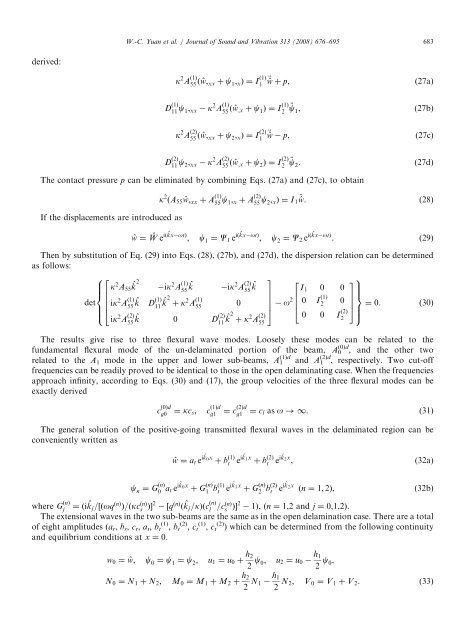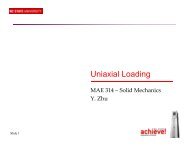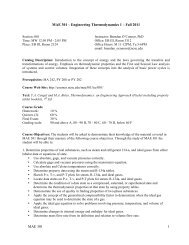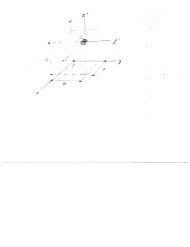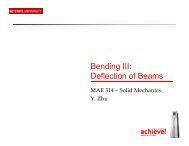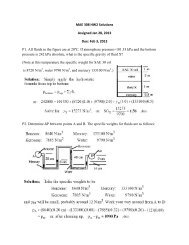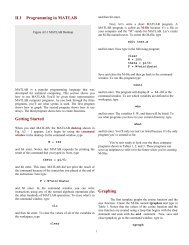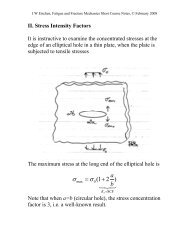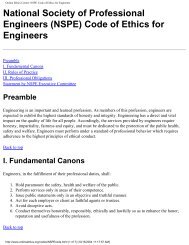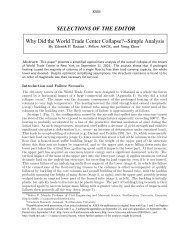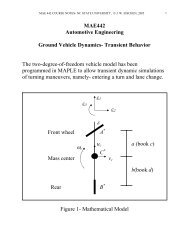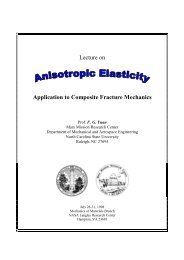Wave reflection and transmission in composite beams containing ...
Wave reflection and transmission in composite beams containing ...
Wave reflection and transmission in composite beams containing ...
You also want an ePaper? Increase the reach of your titles
YUMPU automatically turns print PDFs into web optimized ePapers that Google loves.
ARTICLE IN PRESS<br />
W.-C. Yuan et al. / Journal of Sound <strong>and</strong> Vibration 313 (2008) 676–695 683<br />
derived:<br />
k 2 A ð1Þ<br />
55 ð ^w; xx þ c 1 ; x Þ¼I ð1Þ<br />
1 €^w þ p, (27a)<br />
D ð1Þ<br />
11 c 1; xx k 2 A ð1Þ<br />
55 ð ^w ;x þ c 1 Þ¼I ð1Þ<br />
2 € c 1 , (27b)<br />
k 2 A ð2Þ<br />
55 ð ^w; xx þ c 2 ; x Þ¼I ð2Þ<br />
1 €^w p, (27c)<br />
D ð2Þ<br />
11 c 2; xx k 2 A ð2Þ<br />
55 ð ^w ;x þ c 2 Þ¼I ð2Þ € 2<br />
c 2 . (27d)<br />
The contact pressure p can be elim<strong>in</strong>ated by comb<strong>in</strong><strong>in</strong>g Eqs. (27a) <strong>and</strong> (27c), to obta<strong>in</strong><br />
k 2 ðA 55 ^w; xx þ A ð1Þ<br />
55 c 1; x þ A ð2Þ<br />
55 c 2; x Þ¼I 1<br />
€^w. (28)<br />
If the displacements are <strong>in</strong>troduced as<br />
^w ¼ ^W e ið ^kx otÞ ; c 1 ¼ C 1 e ið ^kx otÞ ; c 2 ¼ C 2 e ið ^kx otÞ . (29)<br />
Then by substitution of Eq. (29) <strong>in</strong>to Eqs. (28), (27b), <strong>and</strong> (27d), the dispersion relation can be determ<strong>in</strong>ed<br />
as follows:<br />
82<br />
k 2 A 55 ^k2 ik 2 A ð1Þ ^k 55<br />
ik 2 A ð2Þ ^k<br />
3 2<br />
39<br />
55 I det ik 2 A ð1Þ ^k 55<br />
D ð1Þ ^k 1 0 0<br />
><<br />
2 11<br />
þ k 2 A ð1Þ<br />
6<br />
55<br />
0 7<br />
4<br />
ik 2 A ð2Þ ^k 55<br />
0 D ð2Þ ^k<br />
5 o2 0 I ð1Þ<br />
>=<br />
6 2<br />
0 7<br />
4<br />
5 ¼ 0. (30)<br />
>:<br />
2 11<br />
þ k 2 A ð2Þ 0 0 I ð2Þ<br />
2<br />
>;<br />
55<br />
The results give rise to three flexural wave modes. Loosely these modes can be related to the<br />
fundamental flexural mode of the un-delam<strong>in</strong>ated portion of the beam, A 0 (0)d , <strong>and</strong> the other two<br />
related to the A 1 mode <strong>in</strong> the upper <strong>and</strong> lower sub-<strong>beams</strong>, A 1 (1)d <strong>and</strong> A 1 (2)d , respectively. Two cut-off<br />
frequencies can be readily proved to be identical to those <strong>in</strong> the open delam<strong>in</strong>at<strong>in</strong>g case. When the frequencies<br />
approach <strong>in</strong>f<strong>in</strong>ity, accord<strong>in</strong>g to Eqs. (30) <strong>and</strong> (17), the group velocities of the three flexural modes can be<br />
exactly derived<br />
c ð0Þd<br />
g0<br />
¼ kc s ; c ð1Þd<br />
g1<br />
¼ c ð2Þd<br />
g1<br />
¼ c l as o !1. (31)<br />
The general solution of the positive-go<strong>in</strong>g transmitted flexural waves <strong>in</strong> the delam<strong>in</strong>ated region can be<br />
conveniently written as<br />
^w ¼ a t e i ^k 0 x þ b ð1Þ<br />
t e i ^k 1 x þ b ð2Þ<br />
t e i ^k 2 x , (32a)<br />
c n ¼ G ðnÞ<br />
0 a t e i ^k 0 x þ G ðnÞ<br />
1 bð1Þ t<br />
e i ^k 1 x þ G ðnÞ<br />
2 bð2Þ t e i ^k 2 x ðn ¼ 1; 2Þ, (32b)<br />
where G ðnÞ<br />
j ¼ði ^k j =½ðoq ðnÞ Þ=ðkc ðnÞ<br />
s ÞŠ 2 ½q ðnÞ ð ^k j =kÞðc ðnÞ<br />
l<br />
=c ðnÞ<br />
s ÞŠ 2 1Þ, (n ¼ 1,2 <strong>and</strong> j ¼ 0,1,2).<br />
The extensional waves <strong>in</strong> the two sub-<strong>beams</strong> are the same as <strong>in</strong> the open delam<strong>in</strong>ation case. There are a total<br />
of eight amplitudes (a r , b r , c r , a t , b (1) t , b (2) t , c (1) t , c (2) t ) which can be determ<strong>in</strong>ed from the follow<strong>in</strong>g cont<strong>in</strong>uity<br />
<strong>and</strong> equilibrium conditions at x ¼ 0.<br />
w 0 ¼ ^w; c 0 ¼ c 1 ¼ c 2 ; u 1 ¼ u 0 þ h 2<br />
2 c 0; u 2 ¼ u 0<br />
h 1<br />
2 c 0,<br />
N 0 ¼ N 1 þ N 2 ; M 0 ¼ M 1 þ M 2 þ h 2<br />
2 N 1<br />
h 1<br />
2 N 2; V 0 ¼ V 1 þ V 2 . (33)


